
All material by ATW may be used under the terms of a
Public Domain Dedication.
| Glossary | ||
| Plants | Glossary L-O |
| Plant | Plant | Time |
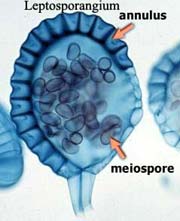
Lateral meristem same as vascular cambium. See cambium.
Leaf a flattened, photosynthetic structure of a plant arranged on a stem.
Leptoid Cells involved in solute storage and transport in Bryophyta. Analogous, possibly even homologous, to the phloem of tracheophytes. Ligrone et al. (2000). See image at hydroid.
Leptosporangium sporangium developed from a single superficial cell.
Leptosporangiate having leptosporangia. This is a derived character state in the fern clade; compare to eusporangium. Image from the Botany 125 site of Prof. Curtis Clark, California State Polytechnic Univ. at Pomona.
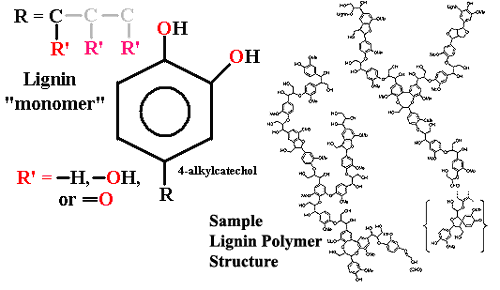
Lignin wood. Lignin is formed by the removal of hydroxyl groups from sugars, creating phenolic compounds and short-chain alcohol ligands. Lignin polymers are heavily cross-linked. There is great variation in lignin, even within the same plant. Undoubtedly, it has evolved to have a somewhat random structure to foil enzymatic attack. Lignin is, in fact, extremely difficult to dissociate -- so much so that even as late as 1980 almost nothing was known of the detailed chemistry of lignin, the second most common biopolymer on the planet (next to cellulose). Fortunately, considerable progress has been made since then. The basic monomer of lignin can be thought of as 4-alkylcatechol. The alkyl ligand is a 1 to 3 carbon chain which may be substituted with hydroxy or keto ligands at any or all positions. Both phenol groups and the alkyl substitutions may cross-link to other monomers or their side chains, yielding a fairly light, but strongly cross-linked and randomly ordered mass, i.e., wood. What is more, the chemical structure virtually guarantees that any intermediate degradation product will be a highly toxic phenolic compound. Lignin was a rather early product of plant evolution. The necessary implication is that, contrary to most current thought on the subject, land plants were subject to biological attack although not necessarily attack by herbivorous animals) by at least the Middle Devonian, and probably even earlier.
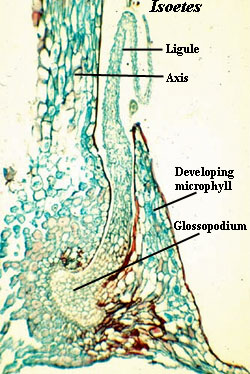
Ligule small protuberance from the base of a leaf. "The ligule is a small, leaflike structure situated on the adaxial side of vegetative leaves and sporophylls ... . Once thought characteristic only of heterosporous lycopsids, a ligule has recently been documented in the homosporous fossil lycopsid Leclercqia complexa ... ." Kenrick & Crane (1997). These authors believe that the ligule in lycopsids is homologous to both the sporangium and the microphyll. Image: lingitudinal section of the extant lycopsid Isoetes, showing a ligule. Image adapted from the Plant Fossils and Evolution site of Prof. Kathleen Pigg (Arizona State Univ.).
Lobed margin (leaves) margin indented one quarter or more of the distance from the margin to the mid-vein or (where this is lacking) to the long axis of the leaf; compare entire margin and toothed margin leaves
Locule, alternatively loculus (pl. loculi) a chamber, compartment or other limited volume which is used to accumulate or store either gametes or spores. Typically, the locule contains only gametes or spores. Thus a sporangium is a spore-producing organ, but a locule within the sporangium is where the spores are accumulated before release.
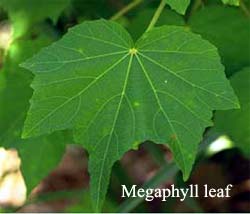
Manoxylic wood type that contains abundant parenchyma; typical of cycads; compare with pycnoxylic.
Megagamete the "female" gamete, analogous to an egg and sometimes referred to as an ova (Latin for egg).
Megagametophyte in heterosporous plants and in seed plants, the female gametophyte produced by a megaspore.
Megaphyll a leaf with branched veins and a flat area for receiving sunlight.
Megasporangium a sporangium that produces megaspores; see also heterosporous.
Megaspore a large, haploid (N=1) spore of a heterosporous plant that produces a megagmetophtye (female gametophyte)

Meiosis A process common to almost sexual reproduction in eukaryotic cells. The homologous chromosomes of a diploid nucleus first exchange homologous genes (alleles) on a roughly random basis, so that the resulting chromosomes carry a mixture of genes from each parent. The nucleus then divides normally (by mitosis) to yield two diploid daughter nuclei. Finally, the nuclei divide again, but now without DNA replication, to yield four haploid cells. Image from the Online Biology Book by Dr. Mike Farabee of Estrella Mountain Community College.
Meristem a plant tissue containing cells that are actively dividing (or have the potential to do so). Meristem found in the tip of roots and stems, the apical meristem, is responsible for the growth in length (primary growth) of these organs. The cambium is a lateral meristem that is responsible for increase in girth (secondary growth) in perennial plants. Some plants also have intercalary meristem, as in the stems of grasses, for example. These are responsible for their continued growth after cutting or grazing has removed the apical meristem of the shoots. Tiscali.
Mesarch "a type of xylem maturation in which the protoxylem is embedded in the metaxylem and development proceeds both centripetally (from the outside in) and centrifugally (from the inside out)." Virtual Paleobotany Laboratory Glossary. Compare centrarch, endarch, exarch.
Mesophyll parenchymal tissue between the upper and lower epidermis of a leaf.
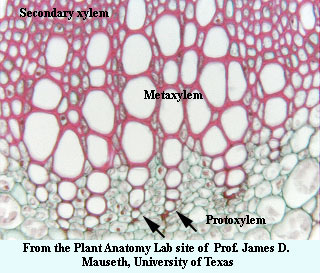
Metaxylem the outer part of the primary xylem, or woody tissue of a plant, generally consisting of wider, thick-walled and/or pitted cells. The metaxylem frequently includes living parenchymal cells. The defining feature of metaxylem is that it develops after the protoxylem but before secondary xylem. Wikipedia. "Two types of vessels mature in characteristic positions [when] primary xylem tissue ... differentiates from the procambium during the early ontogeny of a plant. The protoxylem vessels, which commonly have annular and spiral thickenings, mature before the surrounding organs have elongated. These are frequently destroyed by the extension of the surrounding tissues. The metaxylem vessels, which usually have reticulate and pitted thickenings, mature after the surrounding organs complete their growth. In contrast to protoxylem vessels, they are not destroyed, and constitute the water-conducting tubes of the mature plant ... ." Kubo et al. (2005).
Microgamete the "male" gamete, analogous to sperm.
Microgametophyte in heterosporous plants and in seed plants, the male gametophyte produced by a microspore.
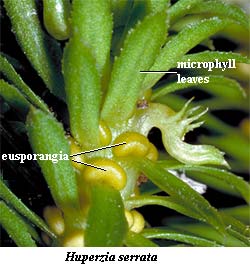
Microphyll a leaf with only one vascular bundle. Kenrick & Crane (1997) apply a developmental definition: "a stem outgrowth that influences the differentiation of axial vascular tissue." Image from the website of Prof. Gerald Carr at the Univ. of Hawaii at Manoa.
Microsporangium a sporangium that produces microspores. Also see heterosporous.
Microspore a small, haploid (N=1) spore of a heterosporous plant that produces a microgametophyte (male gametophyte).
Monocarpic a plant that produces reproductive propagules only once in its lifetime.
Monoecious used to describe a species in which a single plant produces both male and female gametes.
Monophyletic a group descended from a single common ancestor within the group being studied. The term is also used in a slightly different sense. A "monophyletic group" usually refers to a clade, i.e. an organism and all of its descendants. Thus Sinraptor and Allosaurus are (very likely) monophyletic within Allosauroidea. However they are not, by themselves, a clade, because they do not include all descendants of their last common ancestor.
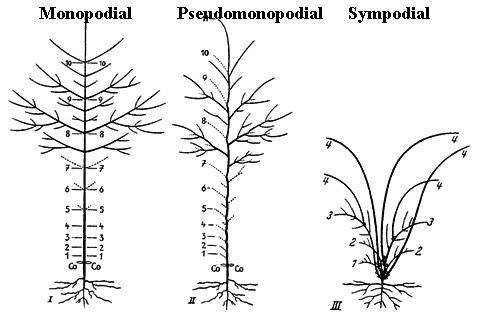
Monopodial of branching patterns, Monopodial branching is a pattern of branching in which there is one main shoot with lateral branches emerging from it. Many firs and spruces exhibit monopodial branching patterns, therefore the Christmas tree image is a good example of monopodial branching. Monopodial branches develop some distance behind the tip of the apical meristem (the growing shoot of the plant). The important implication is that the monopodial branch does not develop from apical meristem. That is, the growing tip of the plant doesn't simply divide in two. Instead, a whole new growth axis is formed -- a lateral meristem. Compare sympodial, pseudomonopodial. Minimally, "In contrast to the pseudomonopodial condition, in monopodial branching there is a developmental lag in the lateral branch trace compared to the xylem in the main axis." Kenrick & Crane (1997: 109). These terms are also used with reference to growth patterns of rhizomes, flowers, etc. They are also quite frequently used wrongly. Some writings define these terms by reference to the branch angle. Monopodial branches are typically >45° from the vertical axis, but the term monopodial refers to a development course, not gross morphology. Other materials restrict monopodial to (?multiple) branches from nodes. That's closer, but too restrictive. It misses the evolutionary point and isn't consistent with the established uses of this term in paleobotany, or its application to structures other than stems which also arise by formation of a secondary growth axis. Image from the Professur für Forstbotanik site of the Universität Freiburg.
Monosaccate a pollen grain with one saccus or buoyant bladder. Compare bisaccate.
Nucellus ovule tissue within which an embryo develops (embryo sac); homologous with the megasporangium of a seed plant.
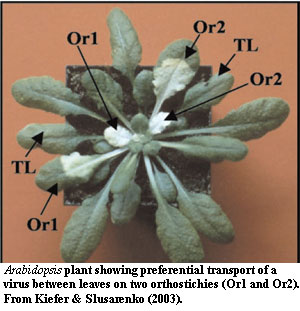
Oogamy reproduction in which the female gamete is large and non-motile and the male gamete small and motile.
Operculum L. for lid or cover. In botany, nearly any kind of lid or cover.
Orthostichy like a number of terms in botany, this word has two meanings -- one morphological and one physiological -- which are usually, but not invariably, equivalent. Morphologically, an orthostichy is "a longitudinal rank, or row, of leaves along a stem," to quote the usual copyright-expired Webster's dictionary. Physiologically, an orthostichy is a series of leaves with a direct vascular connection. Kiefer & Slusarenko (2003). Typically these are the same. That is, leaves with a direct vascular connection lie directly above or below each other, looking down the long axis of the stem. However, this is apparently not always the case. Kenrick & Crane (1997: 297) (referring to "helical orthostichies" in Archaeopteris).
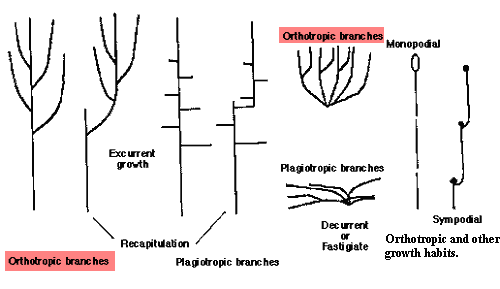
Orthotropic orthotropic growth of branches indicates that the branches grow in the same (ortho) direction as the main shoot, i.e. upwards. Compare plagiotropic. Huber & Hutchings (1997). Image from the Biology of Horticulture site (Ohio State University).
Osmotic pressure Most biological membranes are impermeable to many of the solutes found in the cell. If this were not so, all of the valuable biomolecules in the cell would simply diffuse out and be lost. However, the same membranes are often more or less permeable to water. Since there are many solutes trapped in the cell, the "concentration" of water is lower in the cell than outside, i.e., there are more water molecules per unit volume outside the cell than inside. Diffusion of water through the membrane works both ways and is completely random. However, water "concentration" is higher outside the cell. That is, there are more water molecules in contact with the membrane on the outside than on the inside. So, there will be a net flux of water into the cytoplasm until the concentrations equalize. The osmotic potential is the measure of the net tendency of water to enter the cell. Real cells can't usually behave in this fashion, since the cell will expand and ultimately burst. The problem is handled in numerous different ways, depending on the cell type. In plant cells (and various others), the cell membrane is confined within a semi-rigid cell wall. Water enters the cell only until the elastic reaction force of the cell wall equals the outward force caused by water molecules crowding into the cell. At steady state, the plant cell then maintains a rather high internal pressure, referred to as turgor pressure. Turgor pressure serves as a sort of internal hydrostatic skeleton which helps to support -- and even move -- the plant structures. [I have lost the original source for most of this useful paragraph -- my apologies to the author.]

Ovary the enlarged basal portion of a carpel, where the ovules are borne; the ovary differentiates into the fruit.
Overtopping overtopping or pseudomonopodial growth is a growth habit in which branches depart from a main (usually vertical) axis, rather than by more or less even bifurcation of the axis. To put the matter more simply, overtopping means branching more like a tree and less like a bush. A type of branching in which the apical meristem appears to divide to form two branches, one of which is dominant resulting in an upright main axis with distinct side branches.
Ovule unfertilized seed; the ovule contains the megasporangium with the megagametophyte, surrounded by one or two integuments. See sclerotesta for detailed anatomy of a (fossil) seed.
checked ATW051012
modified ATW090605